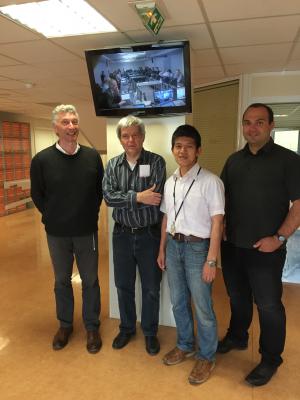The most robust detectors for neutron flux measurements are the fission chambers. A fission chamber is an argon-gas-filled container, whose walls are coated with a thin layer of fissile material such as uranium 235 (U235) or uranium 238 (U238). When a neutron hits a uranium atom, the latter splits and a large amount of energy is released. As the energetic debris travels through the gas-filled volume of the chamber the gas is ionized, and high voltage applied to the electrodes inside the fission chamber results in a current that can be measured. In a later step, the value of this current is calculated into the fusion power of ITER.
In 2012 the ITER Organization
signed a Procurement Arrangement with the Japanese Domestic Agency for the design, manufacture and supply of a diagnostic called micro fission chambers. Four units—containing three micro fission chambers each—will be fitted into the gap between the blanket shield modules and the vacuum vessel.
The neutron fluxes in the areas chosen for the micro fission chambers are extremely high, allowing for the detector modules to be extremely small, with low uranium content (hence the "micro" of their name).
Placing the micro fission chambers close to the plasma also helps to diminish the "scattering effect" and to measure the most direct neutron fluxes. When a neutron travels through material it can "scatter," losing part of its energy. The sensitivity of neutron detectors is energy-dependent; those that are installed far from the plasma are exposed to broad spectra of neutron energies, causing measurement accuracy degradation and making sophisticated neutronic calculations necessary for the interpretation of the data.
Given their location on the inner wall of the vacuum vessel, the front-end components of the detectors will have to be available on site in time for ITER's first assembly campaign when the vessel segments are welded together. It is vital that the installation of these components goes flawlessly, because once the blankets are installed there will be no access to the micro fission chambers for many years. R&D and prototype development are currently underway in Japan to ensure the reliability of all component parts.
Recently, the manufacturing of the mineral-insulated cables that will carry the signal from the detectors to the preamplifiers outside of the vessel was completed. These cables were exposed to 360°C temperature tests for many cycles, followed by vibration, bending, and helium leak tests. All the tests were passed with flying colours. Kiyoshi Itami, the responsible officer of Japanese diagnostic systems, concludes: "We are happy to have achieved this R&D milestone on time and plan to keep the same momentum up to the final delivery of the micro fission chamber system."
The micro fission chambers from Japan will be among the first diagnostics installed on ITER.


